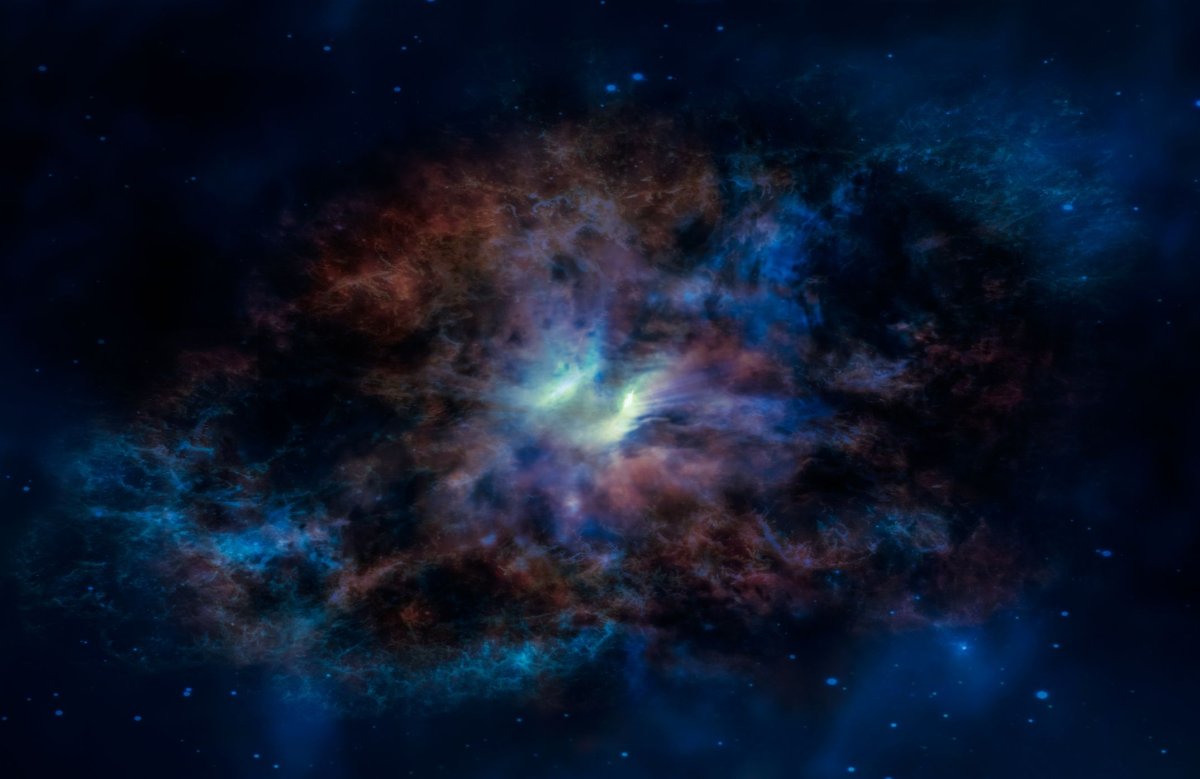About 95 percent of the universe is missing. This cosmic mystery is accounted for by the existence of dark matter and dark energy. The former makes up about 27 percent of the universe, while the latter is 68 percent.
The problem with dark matter and dark energy is that they are "dark." Normal matter—the stuff that makes the stars and planets, for example—can be seen. But dark matter and dark energy does not appear to absorb or emit any electromagnetic radiation, making it invisible. Scientists know they exist because of the gravitational effects they have on observable matter—details of their physical properties are lacking.
A new theory put forward by Jamie Farnes, from the U.K.'s University of Oxford, attempts to help solve some of the mysteries surrounding dark matter and dark energy by unifying them into one bizzare "dark fluid" that has a negative mass.
His study, published in Astronomy and Astrophysics, Farnes discusses the possibility of a fluid that has a type of "negative gravity," which repels all other material around us. If you were to push negative mass matter, it would accelerate towards you, rather than away.
The idea of negative masses has been linked to dark matter and energy before. However, the idea has generally been abandoned because it does not fit with observational evidence: "We know that matter—such as negative mass particles—would become more spread out as the universe expands," Farnes told Newsweek. "However, observations of dark energy show that this unknown substance does not thin out with time—in fact it stays equally constant during the expansion of the universe." To solve this problem, Farnes has modified Einstein's theory of general relativity to allow for negative mass and matter creation.
Matter creation—an early alternative to the Big Bang—says matter is constantly being created to replenish material as the universe expanded. We now know this is not the case for normal matter—but it still could hold true for negative matter, Farnes said.

"In this new theory, the negative mass particles are continuously created, so the particles are always replenished as the universe expands," he explained. "In this new approach, these continuously-created negative masses seem to be identical to dark energy." By combining negative mass and matter creation, dark matter and dark energy can be unified into one single substance—a "dark fluid."
One of the reasons we know dark matter exists is its gravitational influence over galaxies. Observations show galaxies are spinning far faster than they should—so fast they should be torn apart. Dark matter, it appears, is helping to hold them together. To test his theory, Farnes created a 3D computer model of his dark fluid to see if it would hold a galaxy together. And it did. "The new model has been tested using a simulation of the universe within a computer, and seems to naturally generate dark matter halos around 'positive mass' galaxies. This is a direct observational expectation of dark matter, and so seems to indicate that the model has promise. However, there is still much work to be done to test this idea further."
Farnes says are limitations to the research: "The current model provides no explanation at all for the particle physics that may make negative masses possible," he said. "This is currently half of all known physics that is not being included into my model!"
However, he also says the nature of mass is poorly understood in particle physics, so ideas of negative mass could be incorporated to explain other scientific conundrums.
Farnes is now looking to find ways to test the theory—the model predicts galaxies should be distributed in a very well-defined way. Telescopes and data analysis tools currently being created will allow him to measure the distribution of galaxies further back in time than ever before—and this should hopefully allow him to detect evidence "pretty quickly." The only problem is that this technology is unlikely to be ready until 2030.
Alex Murphy, Professor of Nuclear & Particle Astrophysics at the U.K.'s University of Edinburgh, who was not involved in the study, said the findings are interesting: "It's one of many efforts trying to provide answers to deeply troubling issues with our understanding of the contents of the universe," he told Newsweek. "The key result is that if there is the right amount of negative mass matter in the universe, then one can explain the observed motions and distributions of galaxies that otherwise require dark matter and dark energy to exist. That is quite elegant."
Murphy said much more effort will be required to see if the model holds up against a vast breadth of astronomical observations, it is an interesting starting point. "While all this may seem tremendously speculative (and it is!), standard cosmology—and particle physics—is at something of an impasse. It's just possible that an idea like this might provide the breakthrough that's needed."
Uncommon Knowledge
Newsweek is committed to challenging conventional wisdom and finding connections in the search for common ground.
Newsweek is committed to challenging conventional wisdom and finding connections in the search for common ground.
About the writer
Hannah Osborne is Nesweek's Science Editor, based in London, UK. Hannah joined Newsweek in 2017 from IBTimes UK. She is ... Read more
To read how Newsweek uses AI as a newsroom tool, Click here.








